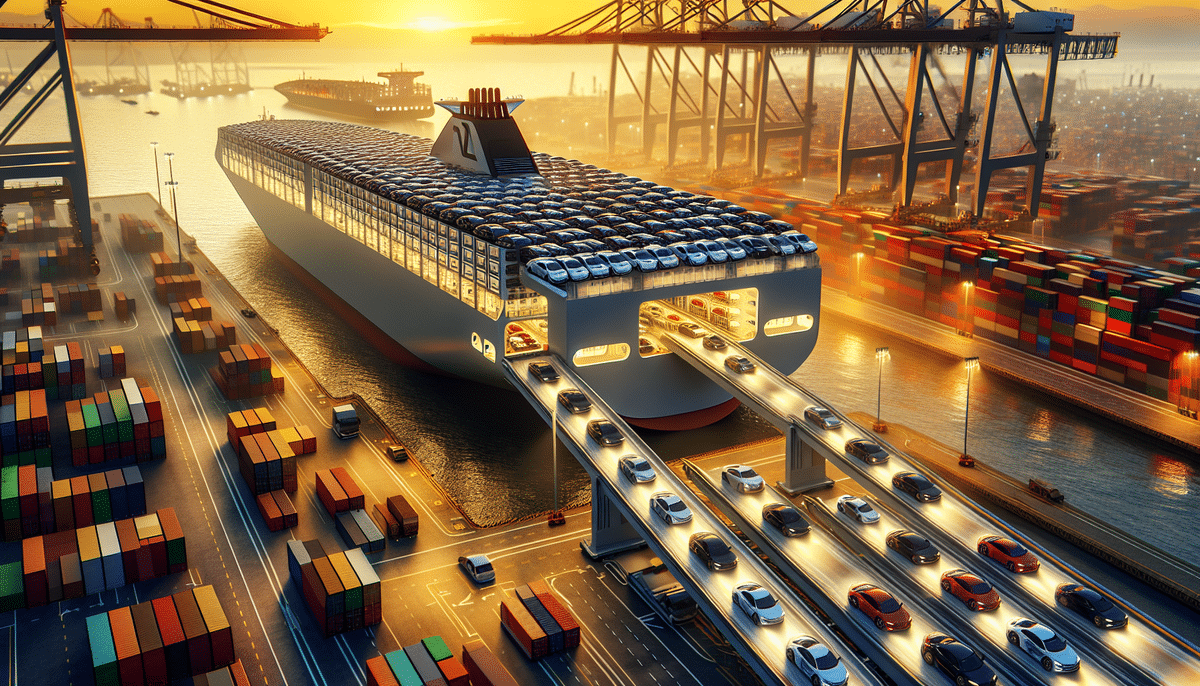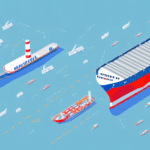Understanding the Benefits of RO/RO (Roll-On/Roll-Off) Shipping
The world of shipping can be complex and intimidating for those who are not familiar with the various modes of transportation available. One of these modes is RO/RO (Roll-On/Roll-Off) shipping, which has become increasingly popular in recent years. In this article, we will discuss the history of RO/RO shipping, how it works, its advantages, and much more, all in an effort to help you understand the many benefits of this transportation mode.
A Brief History of RO/RO Shipping: How It Came to Be
The concept of Roll-On/Roll-Off shipping dates back to the early 20th century, when automobiles began to gain popularity. Initially, cars were transported on cargo ships in a flat position, with each car secured to the deck with chains. This was a slow and laborious process that was not very efficient. Then, in the 1950s, a new concept was developed that would allow cars to be loaded onto ships more easily and quickly. This concept involved the use of ramps that would allow cars to be driven onto the vessel and secured in place. By the 1960s, the RO/RO method had become the standard method for shipping cars, and it has since been adopted for the transportation of other types of cargo as well.
One of the main advantages of RO/RO shipping is that it allows for faster loading and unloading times. This is because the cargo can be driven directly onto the ship, rather than being lifted on and off with cranes. Additionally, the use of ramps and specialized equipment means that the cargo can be loaded and secured more efficiently, reducing the risk of damage during transit.
Today, RO/RO shipping is used to transport a wide range of cargo, including cars, trucks, buses, and heavy machinery. It is particularly popular for the transportation of vehicles, as it allows for large quantities of cars to be shipped at once, reducing the overall cost of transportation. According to ShipScience, the global RO/RO market has seen a growth of over 5% annually, reflecting its increasing importance in global trade. As international trade continues to expand, the utilization of RO/RO shipping is expected to rise, offering a cost-effective and efficient way to transport goods across the world's oceans.
What is RO/RO Shipping and How Does It Work?
RO/RO shipping is a method of transporting goods on a vessel that is specially designed to load and unload cargo by simply rolling it on and off the ship. This is achieved by using specialized ramps and doors that allow vehicles or cargo to be driven or towed directly onto the vessel, which is completely open and has no walls. The cargo is then secured to the deck or held in place in designated areas of the vessel, and transported to its destination. The process of loading and unloading cargo is fast and efficient, making it an attractive option for shippers and carriers alike.
One of the advantages of RO/RO shipping is its ability to accommodate a wide range of cargo, including:
- Cars
- Trucks
- Buses
- Heavy machinery
- Boats
This versatility makes it a popular choice for manufacturers, dealerships, and individuals who need to transport vehicles across long distances. Additionally, RO/RO vessels are equipped with state-of-the-art technology and safety features, such as fire suppression systems, CCTV cameras, and GPS tracking, to ensure that the cargo is transported safely and securely.
However, there are also some limitations to RO/RO shipping. For example, the cargo must be able to roll on and off the vessel, which means that it cannot be too large or heavy. Additionally, the cargo is exposed to the elements during transport, which can be a concern for certain types of goods. Despite these limitations, RO/RO shipping remains a popular and cost-effective option for many businesses and individuals who need to transport goods across the ocean.
The Advantages of RO/RO Shipping for Carriers and Shippers
RO/RO shipping offers a number of advantages for both carriers and shippers:
- Faster Loading and Unloading: The ability to drive cargo directly onto the ship speeds up the handling process.
- Reduced Operational Costs: Fewer personnel and less equipment are required, lowering overall costs.
- Greater Flexibility: Cargo can be loaded and unloaded at various times, providing flexibility to shippers.
- Lower Risk of Damage: Securely placing cargo in designated areas reduces the likelihood of damage during transit.
- Environmental Benefits: RO/RO vessels are designed to be more fuel-efficient, resulting in fewer emissions compared to other transportation modes.
Another significant advantage of RO/RO shipping is its capacity to transport a wide range of vehicles, including cars, trucks, buses, and heavy equipment. This makes it an ideal method for both personal and commercial transportation needs. Furthermore, RO/RO shipping is considered more environmentally friendly, as it produces fewer emissions than other forms of transportation. This is due to the fact that RO/RO vessels are designed to be more fuel-efficient and produce less pollution.
A Comparison of RO/RO Shipping to Other Transport Modes
When compared to other modes of transportation, such as air freight or trucking, RO/RO shipping offers its own set of advantages:
- Cost-Effectiveness: RO/RO shipping is generally less expensive than air freight, especially for large and heavy cargo.
- Capacity: RO/RO ships can transport a wide variety of cargo, including oversized items, which might be restricted by air or road dimensions.
- Environmental Impact: Ships emit less carbon dioxide per ton of cargo transported compared to airplanes and trucks.
- Accessibility: RO/RO shipping can reach destinations that may not be accessible by truck or plane.
According to the International Air Transport Association (IATA), air freight accounts for nearly 35% of global trade by value but only about 1% by volume. In contrast, RO/RO shipping handles large volumes of cargo more efficiently and sustainably.
The Environmental Benefits of RO/RO Shipping
Apart from its economic benefits, RO/RO shipping also offers significant environmental advantages:
- Reduced Emissions: RO/RO vessels are typically more fuel-efficient, resulting in lower greenhouse gas emissions per unit of cargo transported.
- Fewer Trucks on the Road: By transporting goods via ship, the number of trucks needed for overland transport decreases, reducing overall traffic congestion and emissions.
- Lower Carbon Footprint: RO/RO shipping's efficient design contributes to a smaller carbon footprint compared to other transportation modes.
Additionally, the use of RO/RO shipping can help mitigate the risk of environmental disasters. Ships used in RO/RO operations are equipped with advanced safety systems to prevent oil spills and other hazardous incidents during transportation. According to the Environmental Science & Technology journal, the implementation of stringent safety measures in RO/RO shipping has significantly reduced the occurrence of major oil spills in recent decades.
The Economic Impact of RO/RO Shipping on Global Trade
The economic impact of RO/RO shipping on global trade is substantial:
- Facilitation of International Trade: RO/RO shipping enables the efficient movement of large volumes of goods between countries, promoting economic growth and development.
- Creation of Jobs: The RO/RO shipping industry supports millions of jobs worldwide, from shipbuilding and port operations to logistics and transportation services.
- Market Expansion: The ability to transport heavy and oversized cargo opens up new markets and opportunities for manufacturers and exporters.
For instance, the transportation of automobiles via RO/RO shipping has been a key factor in the globalization of the automotive industry. Manufacturers can now distribute vehicles to international markets with ease, enhancing their global presence and competitiveness.
The Future of RO/RO Shipping: Emerging Trends and Technologies
The future of RO/RO shipping looks promising, with several emerging trends and technologies set to revolutionize the industry:
- Alternative Fuels: The adoption of liquefied natural gas (LNG) and hydrogen as alternative fuels is reducing the environmental impact of RO/RO vessels.
- Automation and Digitization: Advanced automation and digital technologies are enhancing the efficiency and safety of RO/RO operations.
- Autonomous Vessels: The development of autonomous RO/RO ships equipped with advanced sensors and navigation systems is set to transform maritime logistics.
- Blockchain Technology: Implementing blockchain can improve transparency and traceability in the supply chain, reducing fraud and errors.
One of the most promising technologies for RO/RO shipping is autonomous vessels. These ships are equipped with advanced sensors and navigation systems that allow them to operate without a crew on board. This not only reduces the risk of accidents and improves safety but also lowers operating costs by eliminating the need for crew accommodations and support facilities.
Another trend gaining momentum is the use of blockchain technology. This decentralized digital ledger system can be used to track and verify the movement of goods and documents throughout the supply chain, improving transparency and reducing the risk of fraud and errors. By utilizing blockchain, RO/RO shipping companies can streamline their operations and provide better service to their customers.
Common Misconceptions About RO/RO Shipping Debunked
Despite its many advantages, there are still some misconceptions about RO/RO shipping that need to be addressed:
- Safety Concerns: Some individuals believe that RO/RO shipping is unsafe or unsuitable for delicate cargo. However, RO/RO ships are designed specifically for the transportation of various types of goods, and stringent safety measures are in place to ensure secure loading and transport.
- Limited Cargo Types: Another misconception is that RO/RO shipping is only suitable for vehicles. In reality, RO/RO vessels can transport a wide range of cargo, including heavy machinery, construction equipment, and even boats.
- High Costs: Some assume that RO/RO shipping is more expensive than other methods. On the contrary, it is often more cost-effective, especially for large and heavy shipments.
By understanding the true capabilities and safety features of RO/RO shipping, businesses and individuals can make informed decisions about their transportation needs.
Case Studies: Real-World Examples of Successful RO/RO Shipping Operations
There are numerous examples of successful RO/RO shipping operations across various industries. Here are a few notable case studies:
Transportation of Automobiles
The automotive industry heavily relies on RO/RO shipping to distribute vehicles globally. For example, major car manufacturers like Toyota and Volkswagen utilize RO/RO ships to transport thousands of vehicles annually, ensuring timely delivery to dealerships worldwide.
Shipping of Wind Turbines
Wind turbines, being large and complex, are efficiently transported via RO/RO vessels. Companies like GE Renewable Energy have successfully shipped turbine components across oceans, facilitating the growth of renewable energy projects around the world.
Heavy Machinery for Construction
Construction companies often require the movement of heavy machinery to various project sites. RO/RO shipping provides an effective solution for transporting bulldozers, excavators, and other large equipment, reducing transit times and costs.
Choosing the Right RO/RO Service Provider for Your Business Needs
When selecting an RO/RO service provider, it's essential to consider several factors to ensure that your cargo is handled efficiently and safely:
- Experience: Choose a provider with a proven track record in RO/RO shipping.
- Safety Record: Ensure that the company adheres to strict safety standards and regulations.
- Pricing Structure: Compare pricing models to find a service that fits your budget without compromising quality.
- Cargo Capabilities: Verify that the provider can handle the specific types and sizes of cargo you need to transport.
- Network and Routes: A well-established network with numerous routes can offer more flexibility and reliability.
At ShipScience, we pride ourselves on offering comprehensive RO/RO shipping solutions tailored to meet the unique needs of our clients. Our extensive experience and commitment to safety make us a trusted partner in the shipping industry.
Best Practices for Preparing Your Cargo for RO/RO Transportation
Proper preparation of your cargo is crucial for ensuring a smooth RO/RO shipping process. Here are some best practices to follow:
- Secure the Cargo: Ensure that all vehicles or machinery are properly secured to prevent movement during transit. Use appropriate straps, tie-downs, and wheel chocks.
- Labeling: Clearly label your cargo with detailed information, including destination, handling instructions, and any hazardous material indicators.
- Documentation: Prepare all necessary documentation, such as bills of lading, import/export permits, and insurance papers, to avoid delays at ports.
- Inspection: Conduct a thorough inspection of your cargo before loading to identify and address any potential issues.
- Compliance: Ensure that your cargo complies with all relevant international shipping regulations and standards.
Adhering to these best practices can help minimize the risk of damage, ensure compliance with regulations, and facilitate a smooth shipping process.
Challenges and Solutions in Implementing a Successful RO/RO Shipping Strategy
While RO/RO shipping offers numerous benefits, there are also challenges that businesses may encounter:
- Port Infrastructure: Not all ports are equipped to handle RO/RO vessels. Investing in ports with the necessary infrastructure is essential.
- Regulatory Variations: Navigating different regulations across countries can be complex. Partnering with knowledgeable service providers can help mitigate this issue.
- Specialized Equipment: Handling certain types of cargo may require specialized equipment. Ensuring access to the right tools is crucial for efficient operations.
To overcome these challenges, businesses should:
- Collaborate with experienced RO/RO service providers who understand the intricacies of international shipping.
- Invest in training and development for staff to stay updated on the latest regulations and best practices.
- Leverage technology, such as logistics software and tracking systems, to streamline operations and improve visibility.
By addressing these challenges proactively, businesses can successfully implement an effective RO/RO shipping strategy.
Safety and Security Considerations in RO/RO Shipping Operations
Safety and security are paramount in RO/RO shipping operations. Ensuring the protection of cargo, crew, and the environment requires comprehensive measures:
- Cargo Securing: Properly securing cargo minimizes the risk of shifting and potential damage during transit.
- Fire Suppression Systems: Advanced fire suppression systems are essential for preventing and controlling fires on board.
- Surveillance: CCTV cameras and monitoring systems enhance security by deterring theft and unauthorized access.
- Emergency Protocols: Developing and training staff on emergency response procedures ensures preparedness in case of incidents.
- Compliance: Adhering to international safety regulations, such as those set by the International Maritime Organization (IMO), is crucial.
Implementing robust safety and security protocols not only protects the cargo but also ensures the well-being of all stakeholders involved in the shipping process.
What You Need to Know Before Investing in an RO/RO Ship or Terminal
Investing in an RO/RO ship or terminal requires careful consideration of several key factors:
- Initial Investment: Assess the upfront costs associated with purchasing or upgrading RO/RO vessels and terminal facilities.
- Operating Costs: Consider ongoing expenses, including maintenance, fuel, and staffing.
- Regulatory Requirements: Understand the legal and environmental regulations that apply to RO/RO operations in different regions.
- Market Demand: Analyze the demand for RO/RO shipping services in your target markets to ensure profitability.
- Potential ROI: Evaluate the return on investment based on projected revenues and costs over time.
It's advisable to conduct thorough market research and consult with industry experts before making significant investments in the RO/RO sector. This due diligence can help mitigate risks and ensure a favorable return on investment.
Conclusion
In conclusion, RO/RO shipping is a versatile, cost-effective, and efficient way to transport a wide variety of cargo across the globe. While there are challenges and misconceptions surrounding the method, its many benefits make it an attractive option for shippers and carriers alike. By understanding the history, process, advantages, and challenges of RO/RO shipping, you can make informed decisions about transportation options for your business and contribute to the growth and development of the global trade industry.
For more information on RO/RO shipping services and solutions, visit ShipScience.




















